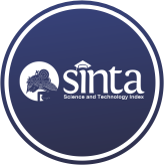Comparative Evaluation of CNN, LSTM, and GRU Architectures for Tsunami Prediction Using Seismic Data
(1) Universitas Katolik Indonesia Atma Jaya, Jakarta, Indonesia
(*) Corresponding Author
Abstract
Full Text:
PDFReferences
A. Suppasri et al., “Cascading disasters triggered by tsunami hazards: A perspective for critical infrastructure resilience and disaster risk reduction,” Int. J. Disaster Risk Reduct., vol. 66, p. 102597, 2021.
C. Reis, M. Lopes, M. A. Baptista, and S. Clain, “Towards an integrated framework for the risk assessment of coastal structures exposed to earthquake and tsunami hazards,” Resilient Cities Struct., vol. 1, no. 2, pp. 57–75, 2022.
L. Velotti, “Natural Hazards: Tsunamis,” in Encyclopedia of Security and Emergency Management, Springer, 2021, pp. 693–696.
N. Mori et al., “Giant tsunami monitoring, early warning and hazard assessment,” Nat. Rev. Earth & Environ., vol. 3, no. 9, pp. 557–572, 2022.
Y. Wang, H. Tsushima, K. Satake, and P. Navarrete, “Review on recent progress in near-field tsunami forecasting using offshore tsunami measurements: Source inversion and data assimilation,” Pure Appl. Geophys., vol. 178, pp. 5109–5128, 2021.
N. Jain, D. Virmani, and A. Abraham, “Tsunami in the last 15 years: a bibliometric analysis with a detailed overview and future directions,” Nat. Hazards, vol. 106, pp. 139–172, 2021.
S. M. Khan et al., “A systematic review of disaster management systems: approaches, challenges, and future directions,” Land, vol. 12, no. 8, p. 1514, 2023.
D. Huang, S. Wang, and Z. Liu, “A systematic review of prediction methods for emergency management,” Int. J. Disaster Risk Reduct., vol. 62, p. 102412, 2021.
S. Al Shafian and D. Hu, “Integrating machine learning and remote sensing in disaster management: A decadal review of post-disaster building damage assessment,” Buildings, vol. 14, no. 8, p. 2344, 2024.
Y. Zhang, “Utilizing Hybrid LSTM and GRU Models for Urban Hydrological Prediction,” University of Guelph, 2024.
Q. Zhang and T. Wang, “Deep Learning for Exploring Landslides with Remote Sensing and Geo-Environmental Data: Frameworks, Progress, Challenges, and Opportunities,” Remote Sens., vol. 16, no. 8, p. 1344, 2024.
H. T. Ganji and E. Seylabi, “An LSTM RNN proposal for surrogate modeling the dynamic response of buried structures to earthquake plane waves in soil half-spaces,” Comput. Geotech., vol. 164, p. 105796, 2023.
E. Cesario, S. Giampá, E. Baglione, L. Cordrie, J. Selva, and D. Talia, “Machine Learning for Tsunami Waves Forecasting Using Regression Trees,” Big Data Res., vol. 36, p. 100452, 2024.
M. Lee, “Rapid prediction of tsunamis and storm surges using machine learning,” 2021.
E. Cesario, S. Giampá, E. Baglione, L. Cordrie, J. Selva, and D. Talia, “A parallel machine learning-based approach for tsunami waves forecasting using regression trees,” Comput. Commun., vol. 225, pp. 217–228, 2024.
L. A. Yates, Z. Aandahl, S. A. Richards, and B. W. Brook, “Cross validation for model selection: a review with examples from ecology,” Ecol. Monogr., vol. 93, no. 1, p. e1557, 2023.
J. B. Rocha Bezerra Junior, “Overcoming Imbalanced Class Distribution and Overfitting in Financial Fraud Detection: An Investigation Using A Modified Form of K-Fold Cross Validation Approach to Reach Representativeness,” 2023.
F. Farahnakian et al., “Addressing imbalanced data for machine learning based mineral prospectivity mapping,” Ore Geol. Rev., p. 106270, 2024.
R. Archana and P. S. E. Jeevaraj, “Deep learning models for digital image processing: a review,” Artif. Intell. Rev., vol. 57, no. 1, p. 11, 2024.
J. Krzywanski, M. Sosnowski, K. Grabowska, A. Zylka, L. Lasek, and A. Kijo-Kleczkowska, “Advanced computational methods for modeling, prediction and optimization—a review,” Materials (Basel)., vol. 17, no. 14, p. 3521, 2024.
M. H. Mobarak et al., “Scope of machine learning in materials research—A review,” Appl. Surf. Sci. Adv., vol. 18, p. 100523, 2023.
P. L. Ford, “Earthquakes Historical Data and Live Data.” Kaggle, 2023. https://www.kaggle.com/datasets/patricklford/earthquakes-historical-data-and-live-data/data.
DOI: https://doi.org/10.30645/kesatria.v6i1.573
DOI (PDF): https://doi.org/10.30645/kesatria.v6i1.573.g568
Refbacks
- There are currently no refbacks.
Published Papers Indexed/Abstracted By:














